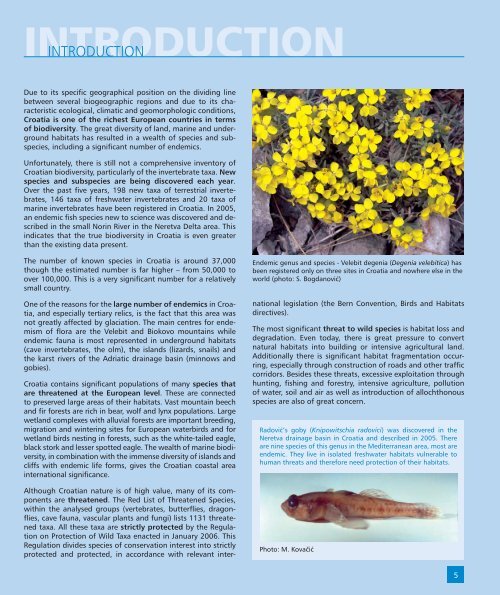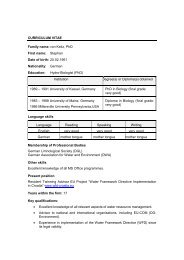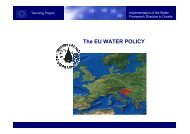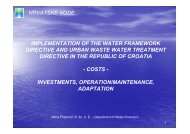BIODIVERSITY OF CROATIA
BIODIVERSITY OF CROATIA
BIODIVERSITY OF CROATIA
You also want an ePaper? Increase the reach of your titles
YUMPU automatically turns print PDFs into web optimized ePapers that Google loves.
INTRODUCTION<br />
Due to its specific geographical position on the dividing line<br />
between several biogeographic regions and due to its characteristic<br />
ecological, climatic and geomorphologic conditions,<br />
Croatia is one of the richest European countries in terms<br />
of biodiversity. The great diversity of land, marine and underground<br />
habitats has resulted in a wealth of species and subspecies,<br />
including a significant number of endemics.<br />
Unfortunately, there is still not a comprehensive inventory of<br />
Croatian biodiversity, particularly of the invertebrate taxa. New<br />
species and subspecies are being discovered each year.<br />
Over the past five years, 198 new taxa of terrestrial invertebrates,<br />
146 taxa of freshwater invertebrates and 20 taxa of<br />
marine invertebrates have been registered in Croatia. In 2005,<br />
an endemic fish species new to science was discovered and described<br />
in the small Norin River in the Neretva Delta area. This<br />
indicates that the true biodiversity in Croatia is even greater<br />
than the existing data present.<br />
The number of known species in Croatia is around 37,000<br />
though the estimated number is far higher – from 50,000 to<br />
over 100,000. This is a very significant number for a relatively<br />
small country.<br />
One of the reasons for the large number of endemics in Croatia,<br />
and especially tertiary relics, is the fact that this area was<br />
not greatly affected by glaciation. The main centres for endemism<br />
of flora are the Velebit and Biokovo mountains while<br />
endemic fauna is most represented in underground habitats<br />
(cave invertebrates, the olm), the islands (lizards, snails) and<br />
the karst rivers of the Adriatic drainage basin (minnows and<br />
gobies).<br />
Croatia contains significant populations of many species that<br />
are threatened at the European level. These are connected<br />
to preserved large areas of their habitats. Vast mountain beech<br />
and fir forests are rich in bear, wolf and lynx populations. Large<br />
wetland complexes with alluvial forests are important breeding,<br />
migration and wintering sites for European waterbirds and for<br />
wetland birds nesting in forests, such as the white-tailed eagle,<br />
black stork and lesser spotted eagle. The wealth of marine biodiversity,<br />
in combination with the immense diversity of islands and<br />
cliffs with endemic life forms, gives the Croatian coastal area<br />
international significance.<br />
Endemic genus and species - Velebit degenia (Degenia velebitica) has<br />
been registered only on three sites in Croatia and nowhere else in the<br />
world (photo: S. Bogdanovi})<br />
Although Croatian nature is of high value, many of its components<br />
are threatened. The Red List of Threatened Species,<br />
within the analysed groups (vertebrates, butterflies, dragonflies,<br />
cave fauna, vascular plants and fungi) lists 1131 threatened<br />
taxa. All these taxa are strictly protected by the Regulation<br />
on Protection of Wild Taxa enacted in January 2006. This<br />
Regulation divides species of conservation interest into strictly<br />
protected and protected, in accordance with relevant international<br />
legislation (the Bern Convention, Birds and Habitats<br />
directives).<br />
The most significant threat to wild species is habitat loss and<br />
degradation. Even today, there is great pressure to convert<br />
natural habitats into building or intensive agricultural land.<br />
Additionally there is significant habitat fragmentation occurring,<br />
especially through construction of roads and other traffic<br />
corridors. Besides these threats, excessive exploitation through<br />
hunting, fishing and forestry, intensive agriculture, pollution<br />
of water, soil and air as well as introduction of allochthonous<br />
species are also of great concern.<br />
Radovi}’s goby (Knipowitschia radovici) was discovered in the<br />
Neretva drainage basin in Croatia and described in 2005. There<br />
are nine species of this genus in the Mediterranean area, most are<br />
endemic. They live in isolated freshwater habitats vulnerable to<br />
human threats and therefore need protection of their habitats.<br />
Photo: M. Kova~i}<br />
5









